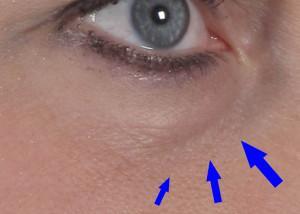The problem: A groove or hollow area is seen below the eyelid, resulting in shadowing and the appearance of a pouch or bag above the groove.
Causes: Hollowing under the eyes usually develops with age, as we lose facial fat, but it is sometimes present in young people. The sunken area often corresponds with the rim of the orbital bone, where the cheek meets the bony cavity that contains the eye. In people who are very thin or who have deep-set eyes, the circular rim of bone that surrounds the eyball can sometimes be visible for 360 degrees around the eye.
In the inner corner of the lower eyelid, a hollow groove is sometimes called the tear trough (when you cry, the tears may roll down this groove). The blinking muscle that encircles the eyelids, just under the skin (orbicularis oculus muscle), is firmly attached to the bone under the tear trough, and this makes that inner groove appear even deeper. The tear trough is accentuated when there is a visible pouch of eyelid fat above the groove.
As fat diminishes and bone shrinks in the cheek with age, the hollowing under the eyes can become more obvious.
Often seen with: Lower eyelid fat pouches (steatoblepharon), cheek and facial fat loss.
Not to be confused with: Lower eyelid hyperpigmentation (skin discoloration), visible eyelid veins, lower eyelid fat bags (steatoblepharon).
What you see in the mirror: Hollow areas under the eyes, with possible dark circles or shadows. The cheeks may be somewhat sunken, and there may be bulging fat in the lower eyelid.
Under-eye hollowing (tear trough)

